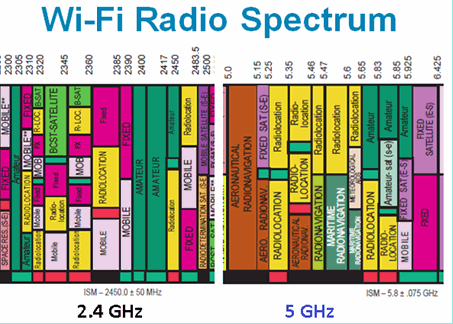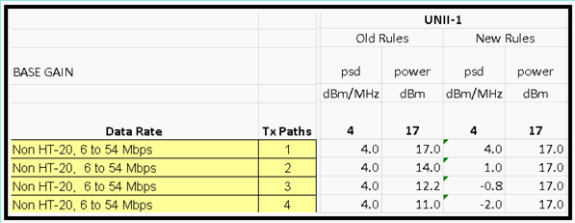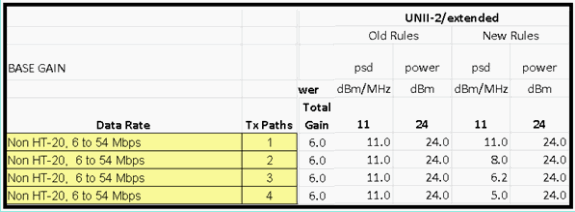Cisco Aironet 3600 Series Access Point and new FCC guidelines
Available Languages
Contents
Introduction
This document provides information about the differences in RF power between the Cisco Access Point (AP) 3500 and the AP 3600.
This document provides insight on FCC rules and use of Power Spectral Density (PSD) requirements that causes a slight reduction in RF power as the new AP 3600 complies with the new FCC rules.
Refer to Cisco Technical Tips Conventions for more information on document conventions.
Q. We are seeing some differences in RF power between the 3500 Series Access Point and the new 3600 Series Access Point. It seems that power might be reduced in the UNII-1 band (channels 36-48) 5150-5240 MHz. Why?
A. Traditionally, the UNII-1 band has always had lower RF power restrictions placed on it because these frequencies are set aside for indoor use only in the United States. During the development of the AP 3600 some new FCC guidelines on RF emissions took effect, which changed the RF power requirements.
Note: The AP 3600 is the first commercial Access Point to be certified under these new guidelines. Review this Wi-Fi spectrum for a better understanding:
Figure 1 - This chart shows the Wi-Fi spectrum and those services that are primary (licensed users). Source: http://www.ntia.doc.gov/osmhome/allochrt.PDF

When looking at the UNII-1 band 5150-5240 MHz (channels 36-48), you can see that the primary or dedicated (licensed use) for this spectrum is for the Aeronautical Radio Navigation service and fixed satellite use, applications such as Microwave Landing systems and outdoor communications.
When the UNII-1 frequencies are used indoors with limited RF power, the FCC permits these frequencies to be used for unlicensed Wi-Fi because such devices can co-exist with limited interference provided the Peak RF power and the Power Spectral Density (PSD) are kept within acceptable levels.
On October 25th 2011, the FCC Office of Engineering and Technology Laboratory Division released a paper about the testing of transmitters with Multiple Outputs in the same band. These new guidelines help to reduce potential interference and apply to Smart Antenna systems and all Wireless LAN products utilizing Multiple Input Multiple Output (MIMO) technology regardless of vendor.
This FCC bulletin was released to address how manufacturers such as Cisco must comply with the new guidelines. These guidelines are available at these FCC URLs:
The “take-away” is that the FCC has introduced additional clarification about the method manufacturers must comply with PSD limits.
From the FCC paper, directional gain calculations can be done using this method:
Directional Gain Calculations—In the re-occurring case of N transmit antennas, each with the same directional gain GANT dBi driven by N transmitter outputs of equal power, directional gain is to be computed as follows:
If any transmit signals are correlated with each other, Directional gain = GANT + 10 log(N) dBi
If all transmit signals are completely uncorrelated with each other, Directional gain = GANT
From the FCC paper—Correlation between signals transmitted from different antennas can lead to array gain, which increases the directional gain of the device and leads to higher radiated levels in some directions. The contribution of array gain to the directional gain of the transmitter must be considered in rule parts where conducted in-band emission limits vary with directional gain, or in situations where conducted measurements are combined with directional antenna gain to determine compliance with in-band radiated limits.
Because the Cisco AP 3600 is the first to market Access Point to comply with the new FCC guidelines, Cisco (and other manufacturers) is now required to reduce RF power in the UNII-1 band and slightly reduce RF power in the UNII-2 and UNII-2 extended bands when releasing new products that take advantage of MIMO or Smart Antenna technology. Or, other methods such as reducing the overall antenna gain permitted by their products.
Again, this is done to reduce potential interference with Aeronautical Radio Navigation services, Radar and fixed satellite communications services.
The key take-away here is that in order to comply with In-Band PSD requirements under the new rules, you must consider the number of transmitter paths and how it effects the total RF power and PSD emissions.
This includes beam-forming whether the beam-forming was intentional or not and given that under certain conditions, RF power can add up driving up the overall PSD value. In order to keep that under the FCC limits, in some cases you have to reduce RF power based on the MCS rate and frequency being used to comply.
The reduced power is more pronounced in the UNII-1 band where PSD limits are lower especially when multiple transmitter paths exist. For example, in the next screenshot you can see under the new FCC rules that the more transmitter paths (physical transmitters) the higher the PSD rises. In some cases, RF power is reduced by 6 dB with four transmitters present.
Figure 2 – When more transmitters are enabled the PSD lowers. This forces a reduction in RF power.Figure 3 - When more transmitters are enabled the PSD lowers. This forces a reduction in RF power. Fortunately this reduction in power is much less in the UNII-2 and UNII-2 extended bands.


When considering the new FCC rules, RF output power is rolled back a bit when all four transmitters are used concurrently to comply with the lowered PSD limitations. A worst case power reduction, for example, a 6 Mbps packet can have up to 6 dB less power with an AP 3600 than the AP 3500 (8 dB versus 14 dB) because the AP 3600 now complies with the new FCC rules about PSD emissions and the two additional transmitters.
In most cases, especially with clients using higher data rates, the reduced TX power is compensated by having a better downlink performance due to the gains from beam-forming now enabled with multiple transmitters and using Cisco Client Link 2.0.
Note: Client Link 2.0 is only available on the AP 3600. Therefore, it has an advantage over the AP 3500 allowing 802.11n and 802.11ac clients to maintain a better downstream link.
Also, while there has been a noticeable reduction in RF power primarily in the UNII-1 band, and while it is possible to perhaps characterize better performance with an AP 3500 running at maximum RF power in the UNII-1 band, testing has indicated the AP 3600 when installed in an over-all network employing multiple APs across channels in the UNII-1, 2 and 3 bands the performance of the AP 3600 exceeds AP 3500 performance by far.
Again, the AP 3500 only has the ability to beam-form to legacy 802.11a/g clients, whereas the newer AP 3600 using Client Link 2.0 can beam-form to 802.11a, g, and n clients as well as 802.11ac clients in compatibility mode.
In summary, the AP 3600 is the first industry Access Point that fully complies with all the new FCC rules and regulations. Also, the AP 3600 offers many features above and beyond those in the AP 3500.
Additionally, any new multi-transmitter MIMO devices, including those by other vendors, now need to comply with these new FCC rules.
Features include:
Support for four transmitter chains, which enables 3-ss client support up to 450 Mbps.
Client Link 2.0 (Beam-forming) for all 802.11n clients for a better overall Bring Your Own Device (BYOD) experience.
Note: The 4th transmitter allows Client Link to work with 3-ss clients.
Module support for expandability and investment protection.
Cisco APs have full support of UNII-2 extended channels, a key feature for the newer clients because more clients are emerging with UNII-2 extended support including .11ac clients in enterprise (802.11n) compatibility mode.
For more information on the AP 3600, refer to: Cisco Aironet 3600 Series.
Related Information
Revision History
| Revision | Publish Date | Comments |
|---|---|---|
1.0 |
06-May-2012 |
Initial Release |
Contact Cisco
- Open a Support Case

- (Requires a Cisco Service Contract)



 Feedback
Feedback